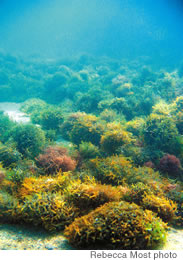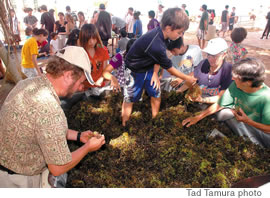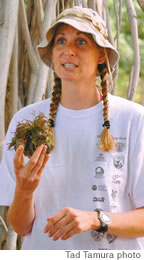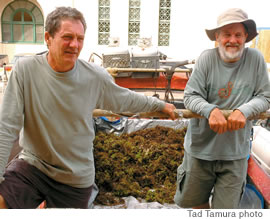Declaring War On Alien Algae
‘Gorilla ogo,’ an alien species of seaweed from the Philippines, is threatening native species — including the good kind used in poke — so dozens of volunteers go on the offensive to root out the bad stuff

A bed of fast-growing ‘gorilla ogo’ in
full bloom
About 100 volunteers gathered near the western wall of the Waikiki Natatorium two Saturdays ago in quest of ogo - not the good-tasting limu manauea that’s popular in poke, but rather its thicker, chunkier relative dubbed “gorilla ogo,” an alien species threatening Hawaii’s nearshore marine ecosystem.
The outing marked the fourth anniversary of the alien algae cleanup, and volunteers came armed with ocean gear and good intentions. “I’m really hoping to learn more about alien algae,” says Shelsey Katsutani, a 23-year-old University of Hawaii student who came to help in the water and had her Morey Boogie board in tow. “I didn’t know what it looked like until I looked on that (display) board. I’m really glad to help the community by doing this.”

Kaliko Thomas, 9, in a bed of seaweed
Another UH student, marine biologist Heather Spalding, had the task of teaching volunteers gathered around sorting tables some Alien Algae 101.
“The gorilla ogo is what we’re going to leave on the tables,” she says, holding a sample. “I’ll take this apart and pass it around. It’s very plasticky feeling. This species was accidentally introduced to Hawaii, and it grows really well. So all these little pieces can then grow into new plants and it can double its size in a few days to weeks. It grows super, super fast. We’re trying to get it out of here and give other species a chance to grow.”

Heather Spalding
Spalding got some “wows” and laughs when she described the mini sea creatures that were to be sorted for return to the sea. She warned about “very small” manta shrimp that will “want to whack you” with its two front appendages, sea cucumbers, starfish and baby morey eels “so small they can’t even get their mouth around your fingers.”
As the first burlap sacks of algae arrive at the tables from the water, farmers Paul and Charlie Reppun of Waiahole wait in the bed of their 1966 Ford pick up for tarp-fulls of gorilla ogo that will be used to fertilize their sweet potato, taro and corn crops. “This corn right here is grown with the limu,” Paul says, referring to bags of corn selling for $3. “We just spread it right on the field and till it in with a tractor. It’s easy.”

Paul and Charlie Reppun take the bad algae to fertilize
their farm
His older brother Charlie adds: “Hopefully we won’t get (the algae) for very long. They’ll get rid of all this stuff,
Page 1 of 2 pages for this story 1 2 >
E-mail this story | Print this page | Comments (0) | Archive | RSS
Most Recent Comment(s):








